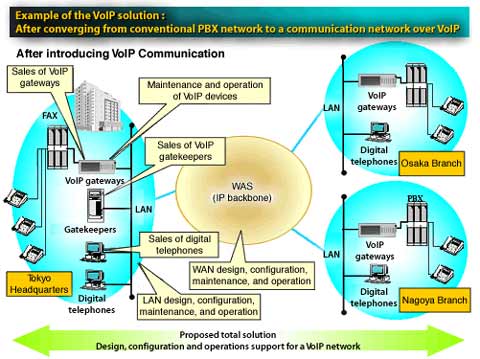
 |
 |

2000.05.23
NTT COMMUNICATIONWARE CORPORATION to launch Voice Data Convergence service
To provide total VoIP-based enterprise solutions
On May 24, 2000, NTT COMMUNICATIONWARE CORPORATION (Head Office: Minato-ku, Tokyo, President: Taneaki Mihara) will launch Voice Data Convergence, a VoIP ( *1 ) -based service that integrates audio and data communications on corporate intranets. By using its extensive knowledge base gained from the experience of adding the VoIP function to its nationwide network, NTT COMMUNICATIONWARE CORPORATION provides total support for corporate communications, from network design and maintenance to the coordination of peripheral devices.



Voice Data Convergence converts conventional corporate internal voice communications into digital information integrated into existing intranet data streams so that voice and data communication can be carried over a single line, thereby achieving a highly efficient, sophisticated network.
For example, research or a business performance evaluation is conducted over internal corporate communication networks between branch offices, with evaluation data analyzed by branch size, difference in usage conditions of internal communication networks among branches, and other high-level considerations. Development is conducted on VoIP related equipment ( *2 ), including advanced VoIP gateways, gatekeepers, frequency bandwidth control units and IP-OpS. The service enables enterprises to own an optimized, low-cost, highly-efficient corporate network, while the advanced QoS function ( *3 ) allows them to maintain high voice quality at a low cost. Various levels of outsourcing are also available for design, system configuration, operations, maintenance. For small businesses, including SOHO, NTT COMMUNICATIONWARE CORPORATION provides ASP services via its own intranet.
NTT COMMUNICATIONWARE CORPORATION launched an integrated internal speech and data communication network in April linking seven major locations, including Tokyo, Nagoya, and Osaka and its California branch offices, after converting analogue speech communication into VoIP and integrating it into its intranet. At present, approximately 6,000 employees uses this communication network. By September, about 9,200 employees in Japan, with 90,000 connecting terminals from Hokkaido to Kyushu, will be able to use the voice/data convergence service. Internal communication costs are projected to be reduced by 70%.


Components of a total solution
· |
IP network analysis, design, configuration, operations, and maintenance
|
| · |
IP traffic data mining ( *4 )
|
| · |
Providing VOIP gateway, VOIP gatekeeper, digital telephones for LAN, IP-TV teleconference, IP-CTI (Web call center), IP-Ops, and other VoIP peripheral devices
|
| · |
ASP service over the advanced NTT COMMUNICATIONWARE CORPORATION intranet
|
| · |
Soft-switching technology ( *5 ) for carriers based on the VoIP solution
|
Reduced Costs
· |
Reducing cost by the statistic multiple effect method ( *6 ) on IP speech traffic
|
| · |
Reducing cost along with reducing the number of network devices by integrating the network
|
| · |
Reducing cost by introducing Voice Data Convergence in small branch offices, where internal lines cannot be installed.
|
Glossary
*1 VoIP (Voice over Internet Protocol)
VoIP is a technique for transmitting speech data over the TCP/IP network on the Internet and/or an intranet. It is adopted in internal corporate lines and internet phones.
*2 VoIP-related product
VoIP peripheral devices for corporate use such as digital phones via PC operations and audio/video teleconference servers integrate speech data onto an in-house IP network. These products support the connection of front and back offices with VoIP networks through VoIP gateways and VoIP gatekeepers.
*3 QoS (Quality of Service)
QoS is a technique that guarantees consistent transmission speed by reserving a unique frequency bandwidth on the network. It plays an important part in real-time radio/television broadcasting and communications in which delays or interruptions of data transmission should not occur.
*4 IP Traffic Data Mining
IP Traffic Data Mining provides a stable, optimized IP network environment based on collecting and analyzing traffic data, and enables users to distribute the load among VoIP peripheral devices during high-volume traffic periods, which are monitored and analyzed for new IP network design.
*5 Soft Switching
Soft switching emulates line-exchanging action over IP networks. This service improves efficiency over carriers' networks. SS7 interfaces implemented in gateways enable carriers to connect existing PSTN with IP networks.
*6 Statistic Multiple Effect Method
The statistic multiple effect method adjusts the frequency bandwidth according to the volume of data as the volume of data is multiplied. In contrast with the time division multiple access method, this method does not occupy bandwidth, and facilitates more efficient line usage.
For more information, please contact:
Kato and Miyagi
Network Services Division,
NTT COMMUNICATIONWARE CORPORATION
TEL: 03-5769-7124
E-mail:help@nws.nttcom.co.jp
|
|
|
|

